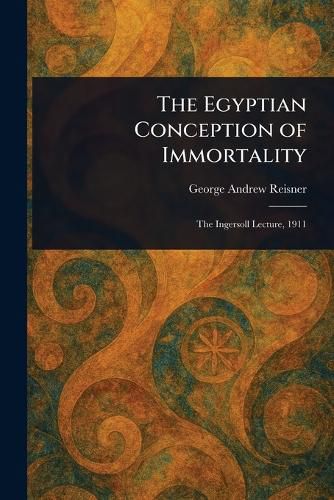Readings Newsletter
Become a Readings Member to make your shopping experience even easier.
Sign in or sign up for free!
You’re not far away from qualifying for FREE standard shipping within Australia
You’ve qualified for FREE standard shipping within Australia
The cart is loading…






This title is printed to order. This book may have been self-published. If so, we cannot guarantee the quality of the content. In the main most books will have gone through the editing process however some may not. We therefore suggest that you be aware of this before ordering this book. If in doubt check either the author or publisher’s details as we are unable to accept any returns unless they are faulty. Please contact us if you have any questions.
Explore the fascinating world of ancient Egyptian beliefs about death and the afterlife with "The Egyptian Conception of Immortality" by George Andrew Reisner. This meticulously republished edition of the 1911 Ingersoll Lecture offers a profound exploration of Egyptian eschatology and their understanding of immortality. Delve into the heart of ancient Egyptian religion as Reisner illuminates their complex system of beliefs surrounding death, resurrection, and the journey into the next world.
Discover the core tenets of their faith and gain insight into the rituals and practices designed to ensure a successful transition to the afterlife. This study sheds light on the enduring human fascination with what lies beyond, offering a glimpse into a civilization deeply concerned with questions of existence, mortality, and the possibility of eternal life. A vital resource for anyone interested in ancient Egypt, religious history, or the history of beliefs surrounding death and the afterlife.
This work has been selected by scholars as being culturally important, and is part of the knowledge base of civilization as we know it.
This work is in the public domain in the United States of America, and possibly other nations. Within the United States, you may freely copy and distribute this work, as no entity (individual or corporate) has a copyright on the body of the work.
Scholars believe, and we concur, that this work is important enough to be preserved, reproduced, and made generally available to the public. We appreciate your support of the preservation process, and thank you for being an important part of keeping this knowledge alive and relevant.
$9.00 standard shipping within Australia
FREE standard shipping within Australia for orders over $100.00
Express & International shipping calculated at checkout
This title is printed to order. This book may have been self-published. If so, we cannot guarantee the quality of the content. In the main most books will have gone through the editing process however some may not. We therefore suggest that you be aware of this before ordering this book. If in doubt check either the author or publisher’s details as we are unable to accept any returns unless they are faulty. Please contact us if you have any questions.
Explore the fascinating world of ancient Egyptian beliefs about death and the afterlife with "The Egyptian Conception of Immortality" by George Andrew Reisner. This meticulously republished edition of the 1911 Ingersoll Lecture offers a profound exploration of Egyptian eschatology and their understanding of immortality. Delve into the heart of ancient Egyptian religion as Reisner illuminates their complex system of beliefs surrounding death, resurrection, and the journey into the next world.
Discover the core tenets of their faith and gain insight into the rituals and practices designed to ensure a successful transition to the afterlife. This study sheds light on the enduring human fascination with what lies beyond, offering a glimpse into a civilization deeply concerned with questions of existence, mortality, and the possibility of eternal life. A vital resource for anyone interested in ancient Egypt, religious history, or the history of beliefs surrounding death and the afterlife.
This work has been selected by scholars as being culturally important, and is part of the knowledge base of civilization as we know it.
This work is in the public domain in the United States of America, and possibly other nations. Within the United States, you may freely copy and distribute this work, as no entity (individual or corporate) has a copyright on the body of the work.
Scholars believe, and we concur, that this work is important enough to be preserved, reproduced, and made generally available to the public. We appreciate your support of the preservation process, and thank you for being an important part of keeping this knowledge alive and relevant.